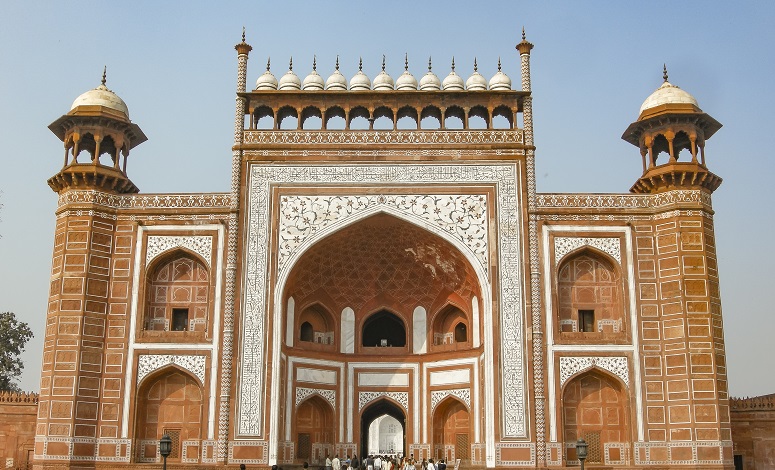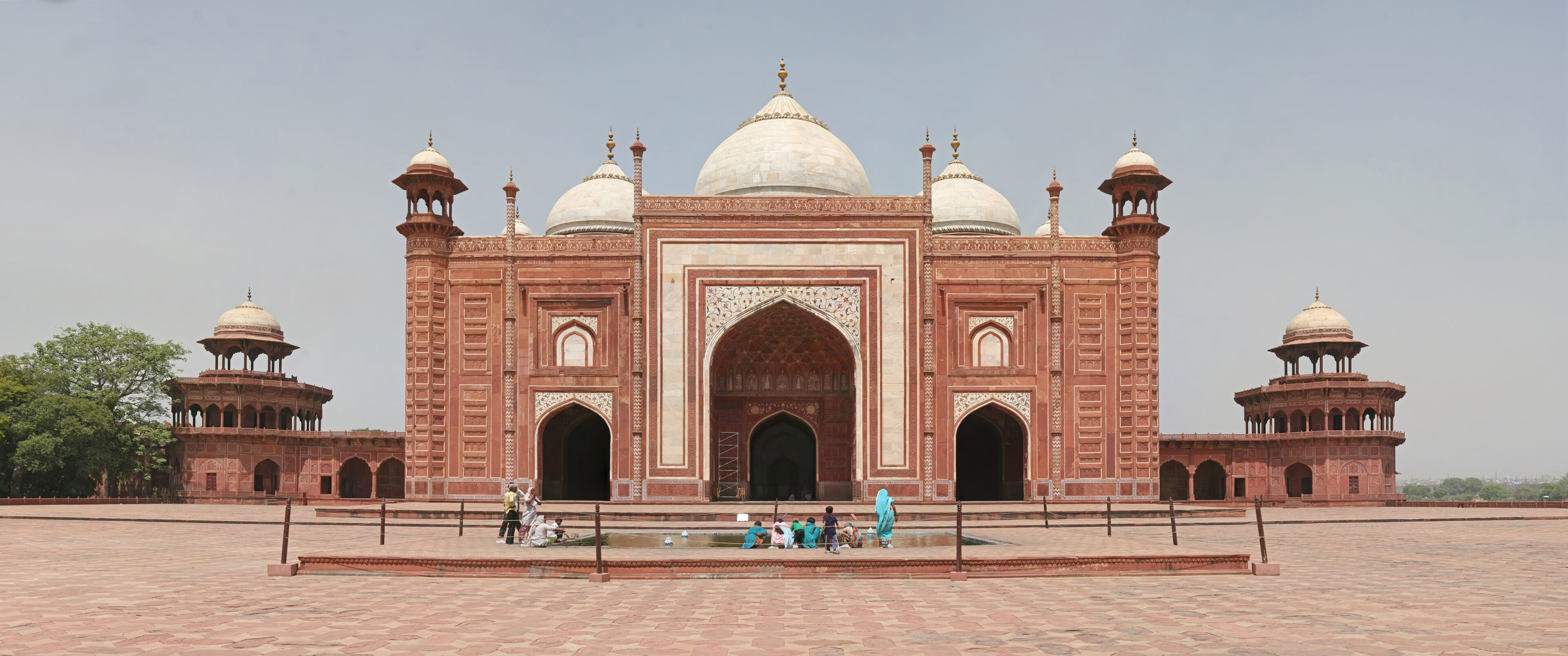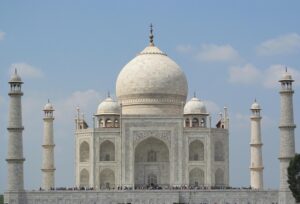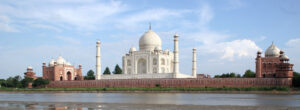
The Taj Mahal (Literally : ´´Crown of the Palace´´) is an ivory-white marble mausoleum on the south bank of the Yamuna river in the Indian city of Agra. It was commissioned in 1632 by the Mughal emperor Shah Jahan (reigned from 1628 to 1658) to house the tomb of his favourite wife, Mumtaz Mahal. It also houses the tomb of Shah Jahan himself. The Taj Mahal is an extensive complex of buildings and gardens that extends over 22.44 hectares (55.5 acres) and includes subsidiary tombs, waterworks infrastructure, the small town of Taj Ganji to the south and a ‘moonlight garden’ to the north of the river. The tomb is the centrepiece of a 17-hectare (42-acre) complex which includes A mosque, A guest house and is set in formal gardens bounded on three sides by a crenellated wall. The Taj Mahal it is one of the most famous and recognizable buildings in the world and while the large domed marble mausoleum is the most familiar part of the monument


TAJ MAHAL : JAWAB & MOSQUE
Mosque
- The mausoleum is flanked by two almost identical buildings on either side of the platform
- To the west is the Mosque, to the east is Jawab
- The Jawab, meaning ‘answer’ balances the bilateral symmetry of the composition and was originally used as a place for entertaining and accommodation for important visitors
- It differs from the mosque in that it lacks a mihrab, a niche in a mosque’s wall facing Mecca, and the floors have a geometric design, while the mosque floor was laid out with the outlines of 569 prayer rugs in black marble
- The mosque’s basic tripartite design is similar to others built by Shah Jahan, particularly the Masjid-i-Jahan Numa in Delhi – a long hall surmounted by three domes
- Mughal mosques of this period divide the sanctuary hall into three areas :
- A main sanctuary with slightly smaller sanctuaries to either side
- At the Taj Mahal, each sanctuary opens onto an enormous vaulting dome
TAJ MAHAL : GARDENS (CHAR BAGH)
Walkways beside reflecting pool
- The large charbagh (a form of Persian garden divided into four parts) provides the foreground for the classic view of the Taj Mahal
- The complex is set around a large 300-metre (980 ft) square charbagh or Mughal garden
- The garden uses raised pathways that divide each of the four-quarters of the garden into 16 sunken parterres or flowerbeds
- Halfway between the tomb and gateway in the centre of the garden is a raised marble water tank with a reflecting pool positioned on a north-south axis to reflect the image of the mausoleum
- The elevated marble water tank is called al Hawd al-Kawthar in reference to the “Tank of Abundance” promised to Muhammad
- The garden’s strict and formal planning employs raised pathways which divide each quarter of the garden into 16 sunken parterres or flowerbeds
- A raised marble water tank at the center of the garden, halfway between the tomb and the gateway, and a linear reflecting pool on the North-South axis reflect the Taj Mahal
- Elsewhere the garden is laid out with avenues of trees and fountains
- The charbagh garden is meant to symbolise the four flowing Rivers of Paradise
- The raised marble water tank (hauz) is called al Hawd al-Kawthar, literally meaning and named after the “Tank of Abundance” promised to Muhammad in paradise where the faithful may quench their thirst upon arrival
- Two pavilions occupy the east and west ends of the cross axis, one the mirror of the other
- In the classic charbargh design, gates would have been located in this location
- In the Taj they provide punctuation and access to the long enclosing wall with its decorative crenellations
- Built of sandstone, they are given a tripartite form and over two storeys and are capped with a white marble chhatris supported from 8 columns
- The original planting of the garden is one of the Taj Mahal’s remaining mysteries
- The contemporary accounts mostly deal just with the architecture and only mention ‘various kinds of fruit-bearing trees and rare aromatic herbs’ in relation to the garden
- Cypress trees are almost certainly to have been planted being popular similes in Persian poetry for the slender elegant stature of the beloved
- The layout of the garden, and its architectural features such as its fountains, brick and marble walkways, and geometric brick-lined flowerbeds are similar to Shalimar’s, and suggest that the garden may have been designed by the same engineer, Ali Mardan
- Early accounts of the garden describe its profusion of vegetation, including roses, daffodils, and fruit trees in abundance
- As the Mughal Empire declined, the tending of the garden declined as well
- When the British took over management of the Taj Mahal, they changed the landscaping to resemble the formal lawns of London
TAJ MAHAL : GREAT GATE (DARWAZA-I RAUZA)
______________________________________________________________________________
- The great gate stands to the north of the entrance forecourt (jilaukhana) and provides a symbolic transition between the worldly realm of bazaars and caravanserai and the spiritual realm of the paradise garden, mosque and the mausoleum
- Its rectangular plan is a variation of the 9-part hasht bihisht plan found in the mausoleum
- The corners are articulated with octagonal towers giving the structure a defensive appearance
- External domes were reserved for tombs and mosques and so the large central space does not receive any outward expression of its internal dome
- From within the great gate, the Mausoleum is framed by the pointed arch of the portal
- Inscriptions from the Qu’ran are inlaid around the two northern and southern pishtaqs, the southern one ‘Daybreak’ invites believers to enter the garden of paradise
- Southern galleries (Iwan Dar Iwan)
- Running the length of the northern side of the southern garden wall to the east and west of the great gate are galleried arcades
- The galleries were used during the rainy season to admit the poor and distribute alms
- A raised platform with geometric paving provides a seating for the column bases and between them are cusped arches typical of the Mughul architecture of the period
- The galleries terminate at each end with a transversely placed room with tripartite divisions
TAJ MAHAL : FORECOURT (JILAUKHANA)
______________________________________________________________________________
- The jilaukhana (literally meaning ‘in front of house’) was a courtyard feature introduced to mughal architecture by Shah Jahan
- It provided an area where visitors would dismount from their horses or elephants and assemble in style before entering the main tomb complex
- The rectangular area divides north-south and east-west with an entry to the tomb complex through the main gate to the north and entrance gates leading to the outside provided in the eastern, western and southern walls
- The southern gate leads to the Taj Ganji quarter
BAZAAR STREET
- Two identical streets lead from the east and west gates to the centre of the courtyard
- They are lined by verandahed colonnades articulated with cusped arches behind which cellular rooms were used to sell goods from when the Taj was built until 1996
- The tax revenue from this trade was used for the upkeep of the Taj complex
- The eastern bazaar streets were essentially ruined by the end of the 19th century and were restored by Lord Curzon restored 1900 and 1908
Inner subsidiary tombs (Saheli Burj)
- Two mirror image tombs are located at the southern corners of the jilaukhana
- They are conceived as miniature replicas of the main complex and stand on raised platforms accessed by steps
- Each octagonal tomb is constructed on a rectangular platform flanked by smaller rectangular buildings in front of which is laid a charbargh garden
- Some uncertainty exists as to whom the tombs might memorialise
- Their descriptions are absent from the contemporary accounts either because they were unbuilt or because they were ignored, being the tombs of women
Northern courtyards (Khawasspuras)
- A pair of courtyards is found in the northern corners of the jilaukhana which provided quarters (Khawasspuras) for the tombs attendants and the Hafiz
- This residential element provided a transition between the outside world and the other-worldly delights of the tomb complex
- The Khawasspuras were restored by Lord Curzon as part of his repairs between 1900 and 1908, after which the western courtyard was used as a nursery for the garden and the western courtyard was used as a cattle stable until 2003
TAJ MAHAL : BAZAAR & CARAVANSERAI (TAJ GANJI)
- The Bazaar and caravanserai were constructed as an integral part of the complex, initially to provide the construction workers with accommodation and facilities for their wellbeing, and later as a place for trade, the revenue of which supplemented the expenses of the complex
- The area became a small town in its own right during and after the building of the Taj.
- Originally known as ‘Mumtazabad’, today it is called Taj Ganji or ‘Taj Market’
- Its plan took the characteristic form of a square divided by two cross axial streets with gates to the four cardinal points
- Bazaars lined each street and the resultant squares to each corner housed the caravanserais in open courtyards accessed from internal gates from where the streets intersected (Chauk)
- Contemporary sources pay more attention to the north eastern and western parts of the Taj Ganji (Taj Market) and it is likely that only this half received imperial funding
- Thus, the quality of the architecture was finer than the southern half
- The distinction between how the sacred part of the complex and the secular was regarded is most acute in this part of the complex
- Whilst the rest of the complex only received maintenance after its construction, the Taj Ganji became a bustling town and the centre of Agra’s economic activity where “different kinds of merchandise from every land, varieties of goods from every country, all sorts of luxuries of the time, and various kinds of necessities of civilisation and comfortable living brought from all parts of the world” were sold
- An idea of what sort of goods might have been traded is found in the names for the caravanserais
- The north western one was known as Katra Omar Khan (Market of Omar Khan)
- The north eastern as Katra Fulel (Perfume Market)
- The south western as Katra Resham (Silk Market) and
- The south-eastern as Katra Jogidas
- It has been constantly redeveloped ever since its construction, to the extent that by the 19th century it had become unrecognisable as part of the Taj Mahal and no longer featured on contemporary plans and its architecture was largely obliterated
- Today, the contrast is stark between the Taj Mahal’s elegant, formal geometric layout and the narrow streets with organic, random and un-unified constructions found in the Taj Ganji
- Only fragments of the original constructions remain, most notably the gates
TAJ MAHAL : PERIMETER WALLS & ANCILLARY BUILDINGS
______________________________________________________________________________
- The Taj Mahal complex is bounded on three sides by crenellated red sandstone walls, with the river-facing side left open
- The garden-facing inner sides of the wall are fronted by columned arcades, a feature typical of Hindu temples which was later incorporated into Mughal mosques
- The wall is interspersed with domed chhatris, and small buildings that may have been viewing areas or watch towers
- Outside the walls are several additional mausolea
- These structures, composed primarily of red sandstone, are typical of the smaller Mughal tombs of the era
- The outer eastern tomb has an associated mosque called the Black Mosque (Kali Masjid) or the Sandalwood Mosque (Sandli Masjid)
- The design is closely related to the inner subsidiary tombs found in the Jilhaukhana – small, landlocked versions of the riverfront terrace with a garden separating the mosque from the tomb. The person interred here is unknown, but was likely a female member of Jahan’s household
TAJ MAHAL : WATERWORKS
- Water for the Taj complex was provided through a complex infrastructure
- It was first drawn from the river by a series of purs – an animal-powered rope and bucket mechanism
- The water then flowed along an arched aqueduct into a large storage tank, where, by thirteen additional purs, it was raised to large distribution cistern above the Taj ground level located to the west of the complex’s wall
- From here water passed into three subsidiary tanks and was then piped to the complex
- The head of pressure generated by the height of the tanks (9.5m) was sufficient to supply the fountains and irrigate the gardens
- A 0.25 metre diameter earthenware pipe lies 1.8 metres below the surface – in line with the main walkway which fills the main pools of the complex
- Some of the earthenware pipes were replaced in 1903 with cast iron
- The fountain pipes were not connected directly to the fountain heads, instead a copper pot was provided under each fountain head: water filled the pots ensuring an equal pressure to each fountain
- The purs no longer remain, but the other parts of the infrastructure have survived with the arches of the aqueduct now used to accommodate offices for the Archaeological Survey of India’s Horticultural Department

